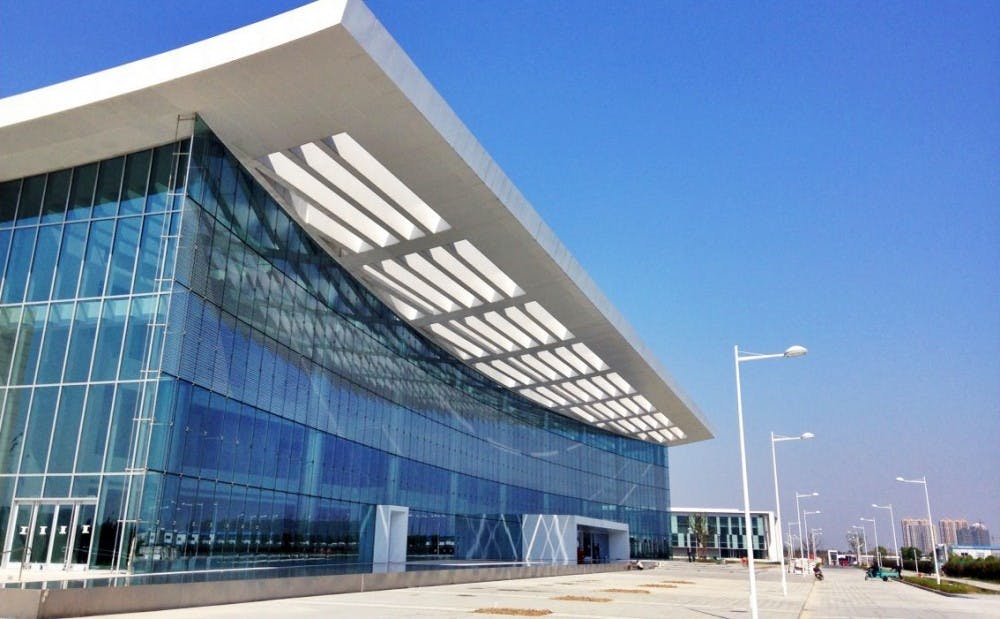Undergraduate students at Duke Kunshan University (DKU) in China will be contributing written and multimedia content to The Chronicle to be published every other Friday.
“To learn a language is to have one more window from which to look at the world.” — Chinese Proverb
The connection between language and cultural identity is a well-established relationship in the social sciences, and for good reason—the languages we speak contain sayings, phrases, and various nuances that only those in the in-group can truly ‘get.’ Speaking with someone in your native tongue asserts a familiarity between speakers that few other cultural commonalities can so readily and directly establish.
And Duke Kunshan, with its melting pot of diversity—so full it feels overflowing—presents a unique context for seeing how specific languages can interact with each other in an environment of surplus. In an almost tower-of-Babel-esque scenario, while the common universal language of instruction is English, which is employed by all professors, Mandarin is (obviously) the preferred language among Chinese students for informal conversation with other Chinese students, and the uber-diverse international population speaks a long list of languages from the world over, while simultaneously building up their own Chinese comprehension together.
This leads to those ‘aha’ moments of illuminative expression when you realize pathways and commonalities between languages that you couldn’t fathom existed; and, by extension, comprehend the true roots and origins of a culture that had just a moment ago seemed so foreign and unrelatable.
Hindi, the national language of India, in its spoken form resembles Urdu, the national language of Pakistan; however, Urdu’s written form is significantly different from that of its Indian cousin, but is fully readable to anyone who knows the Arabic script, even if they can’t comprehend what they read. Arabic also shares some commonalities with Amharic, the official language of Ethiopia, so an Amharic speaker can pick up on some spoken Arabic, which when mixed with French creates the common dialect of Morocco…and on and on can we branch out repeatedly until we encompass all of modern language.
Far from a theoretical exercise, however, such a tree of the connections between languages, at Duke Kunshan, is not some academic construct of linguists, but the cause of the very real and visceral emotions you feel that connect you with those around you—that familiarity when someone greets you in your native tongue, the delight at expressing exactly how you feel when the words of another language just don’t get the point across, and, most importantly, when you are understood—at least partially—by someone you had once presumed to be completely alien to your own culture and way of life.
When we talk about language barriers, we all recognize the positive compulsion that leads us to seek those who simply understand what we’re trying to stay, or the isolation that being the odd one in the group that everyone in the group switches to a different language for—I’ll never forget the time I walked into an event where the guest speaker was speaking in Chinese, and my entry as the sole international in the room required him to switch to delivering the rest of his talk in English—but we fail to notice how those barriers can sometimes have the converse effect of sheltering cultural ideas to be understood in the right context.
The path to learning Chinese, to all international students here, is at its core simply understanding the basic ideas behind Chinese culture; and while this is no accident, as the curriculum is structured to be practical and a real hands-on approach, it’s a marvelous feeling connecting and relating history, tradition and culture to a few simple strokes.
And neither is this limited to stoic ideals of Chinese tradition; this understanding extends to the modern Chinese context, with all its thrills of using Chinese to haggle in the counterfeit markets of Shanghai, trying to hold conversations with strangers while navigating the subway, or simply being able to reply or retort when stopped by Chinese residents asking for a picture.
With all these adventures and connections only five-or-so months into the path towards comprehending the depth of this fundamental relation, we’re only scratching its surface—and there’s no telling how deep it goes.
Aryan Poonacha is a first-year in the second ever graduating class of the Duke Kunshan campus’s undergraduate program, located outside Shanghai, China.
Get The Chronicle straight to your inbox
Sign up for our weekly newsletter. Cancel at any time.

